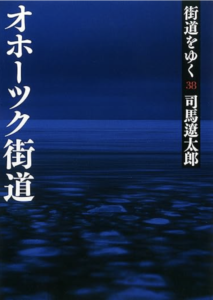Life Tips & Miscellaneous Travel and History Zen Philosophy and History Art and Sport Navigation of this blog
Summary
Travel is an act for human beings to visit new places and experience different cultures and histories. Through travel, people can actually feel historical events and people’s lives by visiting historical places and cultural heritage sites, and can gain a deeper understanding of history and broaden their own perspectives. In this section, we will discuss the historical background of the trip and the places visited based on Ryotaro Shiba‘s “Kaido yuku” (On the Road) about this journey and history.

Kaidou wo yuku Vol. 38 Ohotsuku kaidou.
In the previous article, I described my trip to Mt. Hiei. This time, the journey takes us to the northeastern seashore of Hokkaido to inquire about the mysterious “Okhotskers,” a tribe of marine fishermen. The start of this journey is divided into two parts. The first part of the trip will take us from Sapporo’s Hokkaido Kaitakushi Memorial Museum to Abashiri, where we will stay at the Abashiri Kanko Hotel and visit the Hokkaido Museum of Northern Folklore, Lake Notori, Uwanai with its coral grass, Lake Saroma, Moyoro Shell Mound, and Abashiri City Folk Museum. The second part of the tour will take a 6-hour express train from Sapporo to Wakkanai, arriving in Minami Wakkanai with the Sarobetsu wilderness in sight. After visiting a bar and enjoying shabushabu shabu shabu (water octopus), the group will tour Cape Nukai, Cape Nosappu, and Cape Koe, and then pass through the Soya Hills to Cape Soya, the northernmost cape, to see the monument to Rinzo Mamiya, and to think about Sakhalin and Tartary, 40 km to the north of the country. Traveling south along the coast of the Sea of Okhotsk to Sarufutsu Village, Hamatombetsu, and Edasai Town, the tour will visit the excavation site of the Menashidomari Ruins, the Omusaro Ruins Park in Monbetsu City, and the Okhotsk Drift Ice Science Center before heading to Abashiri, then Koshimizu, Shari Town, and finally the Shiretoko Peninsula, the final destination of the tour.

Sapporo is the capital of Hokkaido, and in addition to beer and ski resorts, it is famous for the annual Sapporo Snow Festival, featuring giant snow and ice sculptures. The Sapporo Beer Museum, which traces the history of beer brewing, has a beer garden and offers tastings. Sapporo is also famous for skiing, with ski resorts and jumps from the 1972 Winter Olympics scattered throughout the city, and the famous ski resort of Niseko is located nearby.

This trip will start at the Hokkaido Kaitakushi Kinenkan in Sapporo.

Incidentally, in the BEST 15 recommended sightseeing spots in the attractive city of Sapporo on the Kinki Nippon Tourist website, Sapporo Clock Tower, Odori Park, the original Sapporo Ramen Yokocho, Maruyama Zoo, Okurayama Observatory, Sapporo Beer Garden, Red Brick Town Hall, Magic Spice, Sapporo TV Tower, Sapporo Nijo Market, The Hokkaido Kaitakushi Kinenkan (Hokkaido Development Memorial Hall) is not mentioned. Among these, the one mentioned in this blog is Moerenuma Park by Isamu Noguchi, which is mentioned in the “Setouchi International Art Festival” section.
Ryotaro Shiba and his party took a 5-hour and 30-minute train ride from Sapporo to Abashiri.

Abashiri City is located on the northeastern coast of Hokkaido and will be a city known for its drift ice on the Sea of Okhotsk.

In Abashiri, the group stayed at the Abashiri Kanko Hotel, which is located halfway up Mt. Tento and overlooks Lake Abashiri, a national park.

From there, the group visited the Hokkaido Museum of Northern Folklore, Lake Notori, the coral grass forests of Ubarauchi, Lake Saroma, the Moyoro Shell Mound, and the Abashiri City Museum of Abashiri Culture. For more information on the Moyoro Ruins, please refer to “On the Road: Okhotsk Highway, the Story of the Moyoro Ruins.
The second part of his Hokkaido trip took him to Wakkanai, a six-hour train ride from Sapporo. Wakkanai City is located in northern Hokkaido and is the northernmost city in Japan, the administrative and economic center of the Soya region, and the gateway to Sakhalin Oblast and other northern regions of Russia.

In Wakkanai, we headed for Minami Wakkanai, seeing the Sarobetsu Wilderness.

Visit a bar and enjoy water octopus shabu-shabu.

After that, we will visit Cape Nukai, Cape Nosabu, and Cape Koe, and then head through the Soya Hills to Cape Soya, the northernmost cape, to see the monument to Rinzo Mamiya, and to think about Sakhalin and Tartary, 40 km to the north.

Mamiya Rinzo was a late Edo Period (1603-1867) courtier of the Tokugawa Shoguns (a courtier is a secret agent or ninja who is secretly engaged in information gathering under secret orders, and often appears in historical novels, as described in “Ryotaro Shiba, Shotaro Ikenami and Historical Novels“), and is known for having confirmed Sakhalin as an island and for having discovered the Mamiya Strait. Rinzo Mamiya is also known as an explorer who discovered the Mamiya Strait and confirmed that Sakhalin was an island. The life of Rinzo Mamiya can be read in detail in the novel “Mamiya Rinzo” by Akira Yoshimura.

Traveling south along the Sea of Okhotsk coast to Sarufutsu Village, Hamatombetsu, and Edasai Town, the tour will visit the excavation site of the Menashidomari Ruins, the Omusaro Ruins Park in Monbetsu City, and the Okhotsk Drift Ice Science Center to ponder the drift ice of Okhotsk.

The trip also ends at the World Heritage Site Shiretoko Peninsula, the final destination of the trip, via Abashiri, Koshimizu, and Shari-cho.



コメント